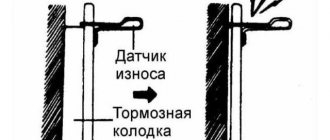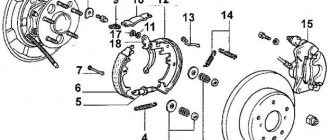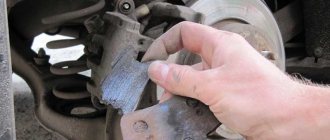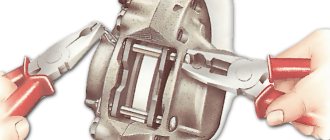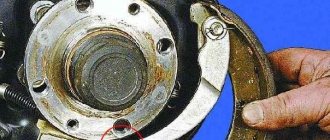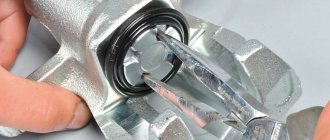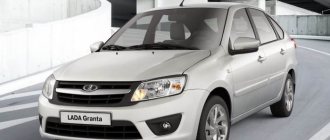The braking system is responsible for safe braking of the car. The efficiency and speed of stopping depends on its serviceability. The number of mechanisms in the brakes is quite large, and they all must work like clockwork, because the failure of one will entail at least unpleasant consequences. Let's talk about what the minimum thickness of brake pads should be, as well as ways to check for wear.
About the main types of pads
The automotive industry has come a long way in recent years. A modern car, as a rule, has an advanced braking system; this is the presence of computer-controlled systems. This should include ABS, directional stability system, etc. The constant development of cars leads to progress in the types of brake pads. The following types are distinguished:
- with a semi-metallic friction layer (65% copper, iron powder, wire);
- organic friction layer (rubber, glass, Kevlar);
- from organics and metallic inclusions in a ratio of 70/30);
- ceramic friction layer with a small inclusion of copper.
Each of the above types has its own strengths and weaknesses. For example, a semi-metallic friction layer has good heat dissipation, but it wears out quickly and makes a lot of noise during operation. But organic brake pads make virtually no noise and operate smoothly, but in the process they emit a lot of dust that settles on the wheel disc. We can safely say that ceramic ones are the most preferable. They do not make noise and do not wear out too quickly. Their only drawback is their high cost.
Why do pads wear out too quickly?
There are several obvious reasons for premature lining wear. Constant driving around the city, when you have to brake often. This leads not only to wear, but also to high temperature of the disc and pads. Many motorists prefer aggressive driving with prolonged and sharp braking. This also results in high wear rates. While a quiet ride often contributes to a long “life” of the brakes.
If you often have to drive with a loaded trunk, then this, on the contrary, helps reduce the load on the front axle and brakes, respectively. In general, it is recommended to change brake pad linings within the time limits specified by the manufacturer. For the rear axle this is usually 40,000 km, and for the front axle approximately 20,000 km. Although they can fail either earlier or later, it is better to carry out regular checks.
What is this detail?
The brake pad is a steel plate with a lining made of materials that can withstand high friction. She constantly works in unfavorable conditions. In addition to the aforementioned friction and subsequent heating, it is affected by water (which leads to a sharp temperature change) and other factors, for example, road reagents. Over time, cracks appear on the surface of the linings, their thickness decreases, and the car begins to brake worse.
When do you need to change brake pads?
In addition to the mileage of the car, manufacturers also indicate the minimum permissible thickness of the friction lining at which replacement is necessary. After all, it often happens that you have already driven 20-30 thousand km, and the pads are like new, or, on the contrary, they have driven a little, and the wear is already critical.
The weight of the car also matters. The less the car weighs, the slower the pads wear out and vice versa. But in most cases, the minimum thickness of brake pads on different brands is almost the same and is 2-3 mm.
Sometimes critical wear can be seen visually without even removing the wheel. In this case, you can stock up on a set for one axle in advance. If the corresponding icon on the dashboard lights up (this option is not available on all cars), it means that the electronic sensor that determines the minimum permissible thickness of the friction linings has been activated.
Limit value of residual thickness
Obviously, the intensity and duration of the impact of the listed circumstances on the service life of the braking system differs for each specific car - one driver drives carefully, another constantly loads the car, a third uses only high-quality original spare parts.
We recommend: Tire pressure sensor: description, faults, types, photos
From a technical point of view, it is incorrect to say that it is time to replace the brake pads if a certain period of time has passed (for example, 1 year) or a certain mileage has been reached. The mileage resource, expressed in km, is an average value and can be used for guidance only.
The following values are usually given: for disc brakes installed on both front and rear axles, it is 10–20 thousand km; for drum wheels, used mainly on the rear wheels – 100–150 thousand km.
In reality, the need for replacement occurs only when the maximum remaining thickness of the lining is reached. The manufacturer usually indicates this value on the product packaging, and the manufacturer - in the maintenance and repair manual. For most modern passenger cars, it fluctuates in the range of 1–2 mm for the brake mechanisms of both front and rear wheels.
About what not to do
Not every car owner regularly checks their brake system. This leads to a variety of consequences, including accidents on the road. This is still good if you crash into a tree in your yard, but what if the brakes fail on the highway? Of course, experienced motorists will use engine braking, but not everyone will have time to figure out what’s going on.
So, never allow the brake pad linings to wear down to metal. This will damage the brake disc and ultimately cause the system to fail. Check the condition of the brakes regularly. It’s not difficult to do this yourself. You shouldn’t crawl under the car every 5 thousand km, but when the time comes, don’t be lazy.
Diagnosis of the cause by wear
Most often, the pads wear out differently on all wheels in a car. Moreover, the front axle is loaded more heavily during braking, since the body tilts forward due to inertia, and the rear axle is unloaded. If the driver uses hard braking, the linings will wear out much faster.
Many modern models are equipped with an ESP system (how the exchange rate stabilization system works is described separately ). The peculiarity of this device is that it automatically brakes when there is a risk of the car skidding. Although such a system provides safety and control of the vehicle, its frequent operation causes wear on individual pads, and this process cannot be controlled. Otherwise, you have to turn off the device (how this is done is described here ).
Here is a short list of the reasons why frequent or unnatural pad wear occurs.
Wedge wear
The reasons for this effect may be:
- Errors when installing pads;
- The material of the block linings is of poor quality;
- A feature of the design of some brake systems, for example, those that are equipped with additional calipers to improve performance;
- The caliper bracket must effectively guide the part so that all parts of it are simultaneously adjacent to the disc. This may not occur due to poor tightening of the mounting bolt;
- Violation of the rules for tightening the fastening bolt of the bracket can lead to its deformation;
- Malfunctions in the chassis of the car, for example, wear in the wheel bearing, which causes play (this happens extremely rarely);
- Souring of guides;
- The bearing on the struts (or strut) has a bent axle.
Rapid pad wear
Accelerated production of material may be due to the following reasons:
- The pad has the wrong material for the specific vehicle, such as being too soft;
- Aggressive driving;
- The car is equipped with an ESP system;
- Development on the brake disc or drum;
- Incorrect caliper adjustment - the pad is pressed against the surface of the disc or drum;
- The car sits idle for a long time.
